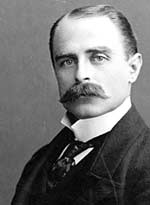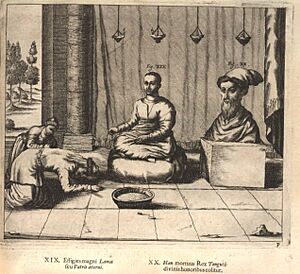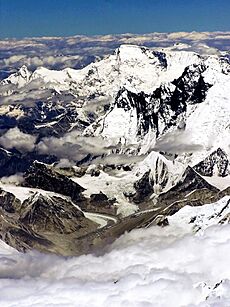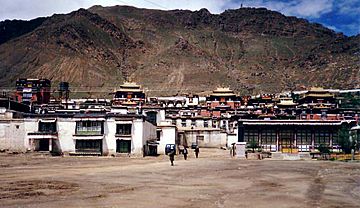History of European exploration in Tibet facts for kids
Tibet is a special place high up in the Himalaya mountains. For a long time, it was very hard for people from Europe to visit. This was because of the tall mountains and also because it was often against the rules for foreigners to enter.
The politics between Tibet, China, Bhutan, Assam, and kingdoms in northern India also made it tough. Because it was so hard to reach and politically sensitive, Tibet remained a mystery and a challenge for Europeans until the 1900s.
Contents
Exploring Tibet: A Journey Through Time
Early European Reports (1100s-1500s)
The first European mentions of Tibet came from a traveler named Benjamin of Tudela. He left Spain in 1160. Based on what he heard, he described Tibet as a land known for musk. He said it was a four-day journey from Samarkand.
About 100 years later, in 1253, a friar named William of Rubruck traveled to Asia. He was sent by King Louis IX of France. Friar William was the first to describe the special clothes worn by Tibetan lamas.
The first European who claimed to have visited Tibet was Odoric of Pordenone. He was a Franciscan friar who said he traveled through Tibet around 1325. His story later became very popular.
By 1459, people in Europe had a clearer idea of where Tibet was. It appeared on the Fra Mauro map in roughly the right place.
First Europeans Arrive (1600s)
The first Europeans confirmed to have reached Tibet were two Portuguese Jesuit missionaries. They were António de Andrade and Manuel Marques. They arrived in July or August of 1624.
Their journey started in Agra, India. They pretended to be Hindu pilgrims to join a group heading towards the mountains. They faced many challenges, including heavy snow and being chased by local rulers.
After a tough journey, Andrade and Marques finally crossed the Mana Pass. They were warmly welcomed by the King and Queen of Guge in Tibet. They stayed for about a month.
In 1625, with the support of the King and Queen, Andrade and Marques set up a permanent mission in Tsaparang.
Another mission was sent to southern Tibet in 1627. The missionaries João Cabral and Estêvão Cacella were welcomed by the King of Utsang in Shigatse. They started a mission there in 1628.
These missionaries also shared the first information about a mystical place called Shambhala. They wrote about it in their reports back to India.
Both missions had to leave Tibet by 1635. This was because they got caught up in a conflict between different Buddhist groups. It would be 25 years before other Europeans visited Tibet.
In 1661, two more Jesuits, Johannes Grueber and Albert Dorville, traveled through Lhasa. They went from Peking (now Beijing) to Agra, India, using a special Imperial Passport.
More Explorers and Missionaries (1700s)
One important missionary was Ippolito Desideri, an Italian Jesuit. He arrived in Lhasa on March 18, 1716. Desideri traveled around the borders of Tibet with Nepal, modern Kashmir, and Pakistan.
After Desideri left, another group of missionaries called the Capuchins took over. They were the only Christian missionaries in Tibet for the next 25 years. However, they faced more and more opposition from Tibetan lamas. They were finally asked to leave Tibet in 1745.
Secret Surveys and Famous Explorers (1800s)

In the late 1800s, many explorers tried to map and understand Tibet.
From 1865 to 1875, an Indian explorer named Nain Singh did secret surveys of Tibet. He was working for the British.

In 1879–80, the Russian explorer Nicholas Przewalski traveled in northern Tibet.
Other explorers like Arthur Douglas Carey and Andrew Dalgleish also traveled in northern Tibet between 1885 and 1887.
In 1889, Gabriel Bonvalot, Prince Henri of Orléans, and Father Constant de Deken crossed the mountain ranges of Tibet.
From 1893–94, Jules-Léon Dutreuil de Rhins and Fernand Grenard explored some of the hardest-to-reach parts of northern and western Tibet.
The Swedish explorer Sven Hedin led three big expeditions to Tibet. These were from 1893–1897, 1905-1909, and 1927-35. He and his team made very accurate maps and documented everything they saw. Hedin's books and talks made him world-famous before World War I.
In 1898, a Canadian doctor named Susie Rijnhart tried to reach Lhasa from the north with her husband and baby. They got very close but had to turn back. Sadly, her baby died, and her husband disappeared. Dr. Rijnhart managed to make it out of Tibet alone.
The first known Japanese explorer of Tibet was a Zen monk named Ekai Kawaguchi. He entered Tibet in 1899 disguised as a Chinese monk. He reached Lhasa and even worked as a therapist for the Dalai Lama.
Russian explorers also reached Lhasa soon after. Gombojab Tsybikov arrived in August 1900, and Ovshe Norzunov in February 1901. They pretended to be Mongolian pilgrims. They were the first photographers of Lhasa whose names are known.
Modern Exploration (1900s)

In 1913, British explorers Frederick Bailey and Henry Morshead explored the Tsangpo Gorge. Later, Tibet officially allowed British expeditions to Mount Everest in 1921 and 1935. However, these expeditions often explored beyond what they were allowed to do.
From May 1938 to August 1939, a German scientific expedition took place. It was led by zoologist Ernst Schäfer.
Today, Tibet is a popular place for tourists. In 2009, 5.6 million tourists visited the Tibet Autonomous Region. They spent a lot of money, showing how much tourism has grown there.
See also
- Catholic Church in Tibet





